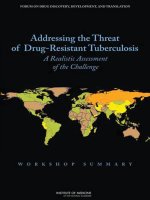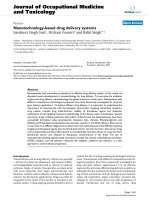THE CHEMISTRY OF DRUG DELIVERY SYSTEMS (hoá học các hệ dẫn truyền thuốc)
Bạn đang xem bản rút gọn của tài liệu. Xem và tải ngay bản đầy đủ của tài liệu tại đây (3.41 MB, 151 trang )
THE CHEMISTRY OF
DRUG DELIVERY SYSTEMS
Dr. Lê Thành Dũng
Org Chem Eng Group
Faculty of Chemical Engineering
Tel: 38647256 ext. 5681
Email:
OBJECTIVES
On the completion of this course, the student should be able
to have a deep understanding of the chemical aspects of
drug delivery systems that have recently attracted attention
from the chemistry and chemical engineering community.
EVALUATION
Seminar: 70%
Final exam: 30%
Students have to work in group for the preparation and the presentation
of their seminar subject. Evaluation will be given based on individual
contribution (preparation, discussion), the oral presentation and the
answers to the questions.
Students will receive a publication on drug delivery system at least one
week before the day of the exam. The exam questions will be based on
the given article.
REFERENCES
1. Martin Malmsten, Surfactants and polymers in drug delivery,
Marcel Dekker, New York, 2002
2. Glen S. Kwon, Polymeric drug delivery systems, Taylor &
Francis Group, New York, 2005
3. Ram B. Gupta, Uday B. Kompella, Nanoparticle technology for
drug delivery, Taylor & Francis Group, New York, 2006
4. Publications in Elsevier, Royal Society of Chemistry, American
Chemical Society, Wiley InterScience journals…
CONTENTS
1. Generalities of drug delivery
2. Liposomes as drug delivery systems
3. Polymers and polymeric systems for drug delivery
4. Dendrimers for drug delivery
GENERALITIES OF
DRUG DELIVERY
DRUG DELIVERY SYSTEM
A drug delivery system is a formulation or a device that safely
brings a therapeutic agent to a specific body site at a certain
rate to achive an effective concentration at the site of drug
action.
Definition:
Roles:
Carry
Transport
Protect
Distribute
Enhance body retention, the efficacy of the treatment
ROUTES OF DRUG ADMINISTRATION
Topical delivery
ORAL DELIVERY
(GASTROINTESTINAL ADMINISTRATION)
ORAL DELIVERY
(GASTROINTESTINAL ADMINISTRATION)
Advantages:
safest
most convenient
most economical
Disadvantages:
poorly absorption of large, highly charged molecules
degradation of drug by stomach acid, various enzymes in
the GI tract
ORAL DELIVERY
(GASTROINTESTINAL ADMINISTRATION)
Dosage forms:
liquids (rapid aborsoped)
dispersed systems: emulsions, suspensions
solids (less absorped): powders, tablets, caplets, capsules
controlled release drug delivery systems
PARENTERAL ADMINISTRATION
IM: into a muscle (intramuscular)
IV: into a vein (intravenous)
SC: under the skin (subcutaneous)
ID: into the skin (intradermal, intracutaneous)
TRANSDERMAL ADMINISTRATION
Advantages:
solution for drugs that can not be administered by oral delivery
reliability, precision of dosage
time control of the onset of action
Disadvantages:
discomfort
possibility of infection
tissue damage
administration by trained personel
MUCOSAL DRUG DELIVERY
Advantages:
avoid the first-pass effect of
drug cleareance
ORAL MUCOSAL ROUTE
Sublingual delivery
Classification:
Buccal delivery
Local delivery
Sublingual delivery
Buccal delivery
Local delivery
Surface area: 100 cm
2
SUBLINGUAL AND BUCCAL DELIVERY
Sublingual
delivery
Buccal
delivery
High
permeability
Less
permeability
Higher
rate of absorption
Low
rate of absorption
Higher
drug bioavailability
Low
drug bioavailability
Rapid
onset of action
Sustained
-release approaches
Constantly
washed by saliva
Relatively
immobile
More
permeable drug
Less
permeable drug (peptides)
Not
include penetration enhancers
Normally
include penetration enhancers
What do you know about saliva?
Saliva: protective aqueous fluid, 1% organic & 99% inorganic
materials
Salivary pH: 5.5 – 7 depending on the flow rate
Flow rate increases [HCO
3
] increases pH increases
Daily salivary volume: 0.5 – 2 L
Oral cavity is a water-rich environment
Selection of hydrophylic matrices as drug carriers
PULMONARY ADMINISTRATION
Large mucosal surface of respitory system for drug absorption
« Taking advantage of the body’s ability to transfer large molecules
through the lung is a better way to deliver drugs than sticking people with
needles »
Patton, Chemtech 1997, 27, 34
PULMONARY ADMINISTRATION
Advantages:
larger surface area (70 m
2
)
very fast onset of action (comparable to intravenous route)
Disadvantages:
lack of reproducibility of the administered dose
variable rate of absorption of drug at different regions
TRANSDERMAL AND TOPICAL ADMINISTRATION
STRUCTURE OF THE SKIN
TRANSDERMAL AND TOPICAL ADMINISTRATION
STRUCTURE OF THE SKIN
Epidermis structure:
TRANSDERMAL AND TOPICAL ADMINISTRATION
STRUCTURE OF THE SKIN
Stratum corneum structure:
Penetration barriers: lipid self-assemblies in the stratum
corneum (10%)
TRANSDERMAL AND TOPICAL ADMINISTRATION
PERMEABILITY ENHANCEMENT
By surfactant-based formulations (penetration enhancers,
liposomes,…):
By hydration of the stratum corneum:
Surfactant-based formulations can interact with lipids and alter
their structure enhance drug penetration
Water can interact with the polar headgroups of lipids through hydrogen
bonding loosen the lipid packing the lipid region becomes more fluid
Enhance drug penetration
PENETRATION ENHANCEMENT
Barry, Int. J. Cosmet. Sci. 1988, 10, 281
PENETRATION (PERMEABILITY) ENHANCERS
Definition:
Compounds that promote the absorption of drugs through the
skin or mucosae, usually by reversibly altering the permeability of
the barrier.
Characteristics:
Non toxic
Pharmacologically inert
Immediate in action
Reversible in action
Chemically & physically compatible with the drug and with the
skin/mucosae
Cosmetically acceptable









